Scenes
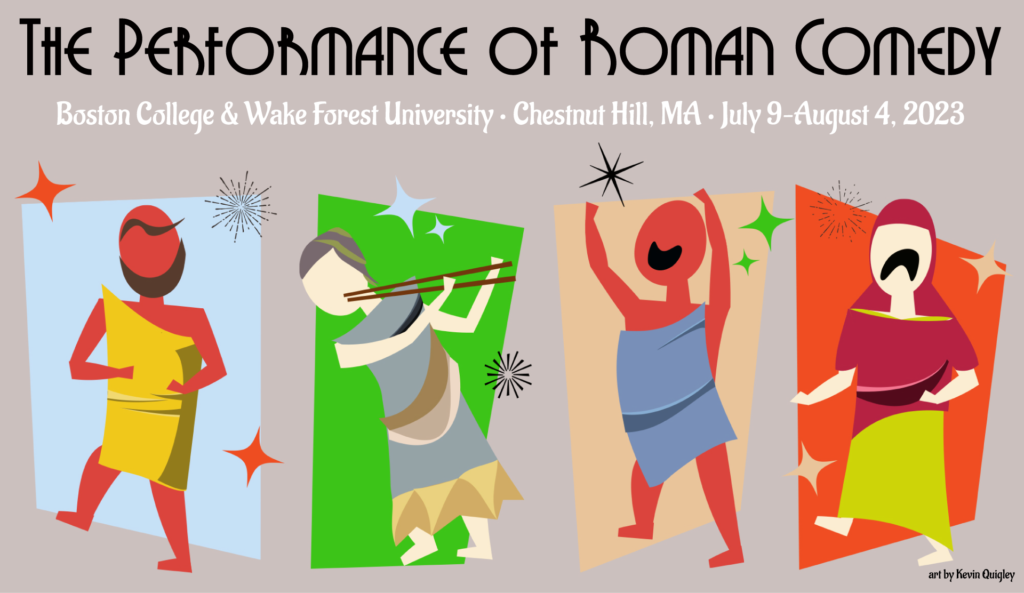
Every participant was involved in the adaptation, rehearsal, performance, recording, and dissemination of two scenes: one ensemble scene, and one two- or three-person scene. The afternoon of each day of the Institute was entirely devoted to preparing the scenes in small groups.
The Institute directors assembled groups with great care, incorporating a variety of considerations, including a participant’s knowledge of Latin or not, ability to read music or not, experience acting or not, experience singing or not, and interest in performance styles (e.g., with full-face masks; improvisational; slapstick).
The scenes below are accompanied by readings tied to each particular scene. These readings were made available to all participants in advance of the Institute.
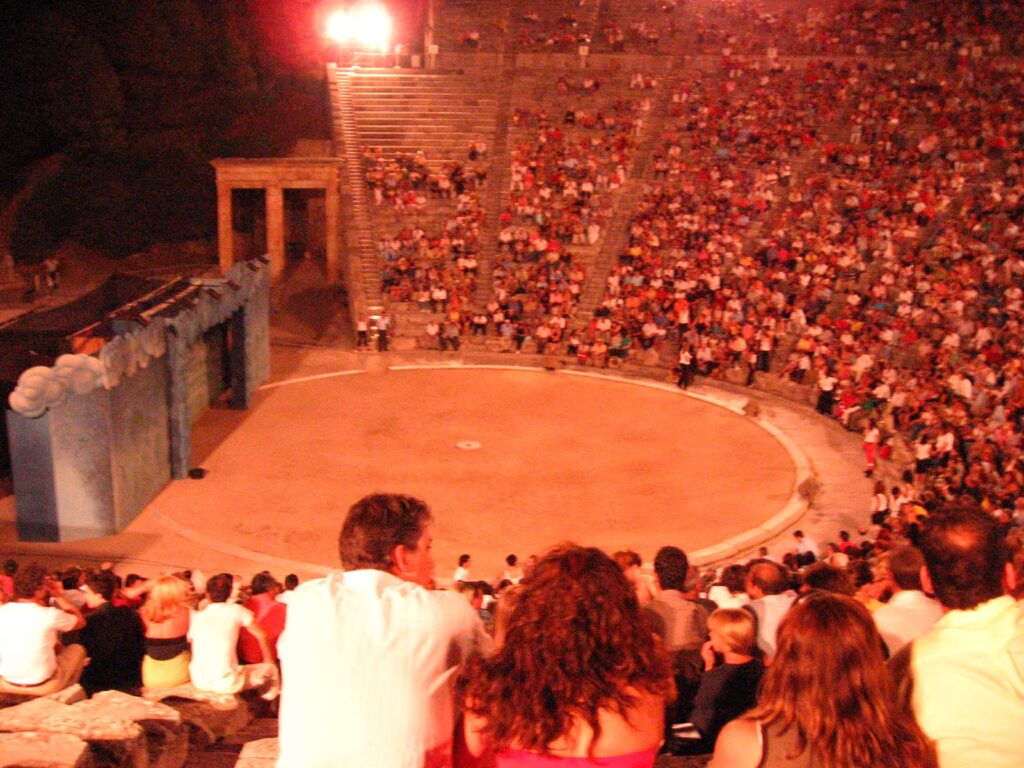
“Ancient Theater in the Peloponnese” by ngupta is licensed under CC BY-NC-SA 2.0 .
Ensemble scenes
Plautus Asinaria 828–947. The play’s finale: the son (Argyrippus) has finally gotten the money to pay for time with the sex-laborer (Philaenium) he’s enamored with, but at the cost of giving the first night of sex to his own father (Demaenetus), who canoodles with Philaenium in front of Argyrippus. Meanwhile, another young man’s unnamed parasite takes vengeance on Demaenetus by exposing him to his wife Artemona, who drags Demaenetus home in shame.
Readings:
- Sharon L. James, “A Courtesan’s Choreography: Female Liberty and Male Anxiety at the Roman Dinner Party,” in Prostitutes and Courtesans in the Ancient World, edd. Christopher A. Faraone and Laura K. McClure (Madison, 2006), pp. 224–251.
- David Konstan, “Plot and theme in Plautus’ Asinaria,” Classical Journal 73 (1978), pp. 215–221.
- Ioannis M. Konstantakos, “The Drinking Theatre: Staged Symposia in Greek Comedy,” Mnemosyne 58 (2005), pp. 183–217.
Plautus Casina 855–1018. The play’s finale: the horny old man and his enslaved overseer Olympio, who have both been trying to get sexual access to Casina during the entire play, have an enslaved man (Chalinus) passed off to them in disguise as Casina, and then have all their misdeeds and sexual misadventures brought out into the open by the enslaved woman Pardalisca, the old man’s wife Cleostrata, and her friend Myrrina.
Readings:
- Catherine Connors, “Scents and Sensibility in Plautus’ Casina,” Classical Quarterly 47.1 (1997), pp. 305-309.
- Barbara Gold, “‘Vested Interests’ in Plautus’ Casina: Cross-Dressing in Roman Comedy,” in Sex and Difference in Ancient Greece and Rome, edd. Mark Golden and Peter Toohey (Edinburgh, 2003), pp. 334–350.
- Elaine Fantham, “Women in Control,” in Women in Roman Republican Drama, edd. Dorota Dutsch, Sharon L. James, and David Konstan (Madison, 2015), pp. 91–107.
- Mahalia L. Way, “Violence and the Performance of Class in Plautus’ Casina,” Helios 27.2 (2000), pp. 187–206.
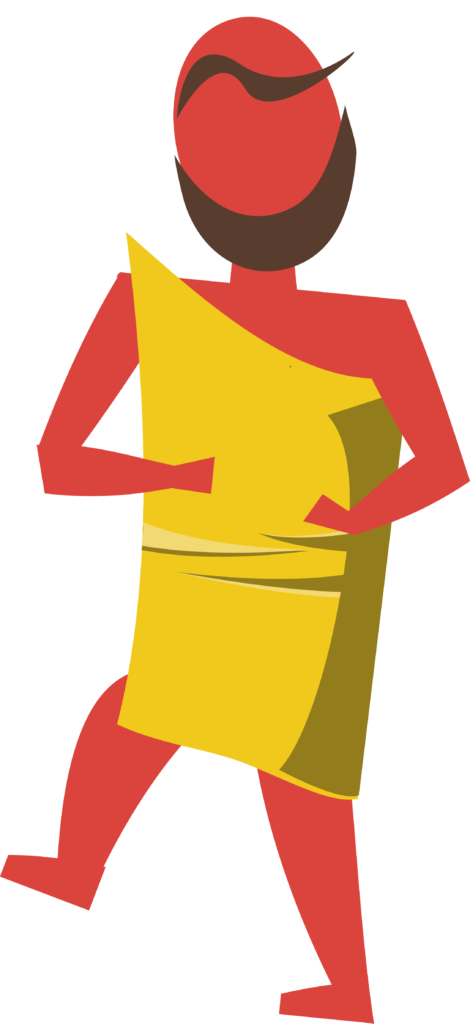
Plautus Curculio 1–215. The play’s opening scene: the young man Phaedromus leads a nighttime procession of people he enslaves, including Palinurus, to visit the house of the sex-trafficker for a tryst with Planesium, whom the sex-trafficker holds enslaved. The drunken door-keeper Leaena sings a solo, there’s a three-part song sequence between her, Phaedromus, and Palinurus, and then Planesium joins for a brief interlude before day breaks and the sex-trafficker returns.
Readings:
- Stavros A. Frangoulidis, “Comic Transformations of Paraclausithyron in Plautus’ Curculio,” in Generic Interfaces in Latin Literature: Encounters, Interactions and Transformations (Trends in Classics Supplementary Volumes 20), edd. Theodore D. Papanghelis, Stephen J. Harrison, and Stavros Frangoulidis (Berlin, 2013), pp. 267–281.
- T. H. M. Gellar-Goad, Plautus: Curculio (London, 2021), pp. 47–85, 117–133.
- Sophia Papaioannou, “What’s in a Name? The Real Identity of Palinurus in Plautus’ Curculio,” Classical Journal 104.2 (2008–2009), pp. 111–122.
Plautus Persa 549–710. The enslaved trickster and lover Toxilus deceives the sex-trafficker Dordalus into purchasing the parasite’s unnamed free daughter, disguised as an enslaved sex-laborer from Persia, with Toxilus’ enslaved sidekick Sagaristio disguised as the play’s titular Persian man.
Readings:
- Clara S. Hardy “The Parasite’s Daughter: Metatheatrical Costuming in Plautus’ Persa,” Classical World 99 (2005), pp. 25–33.
- J. C. B. Lowe, “The virgo callida of Plautus, Persa,” Classical Quarterly 39 (1989), pp. 390–399.
- C. W. Marshall, “Shattered Mirrors and Breaking Class: Saturio’s Daughter in Plautus’ Persa,” Text and Performance 18 (1997), pp. 100–109.
- Frances Muecke, “Plautus and the Theater of Disguise,” Classical Antiquity 5 (1986), pp. 216–229.
Plautus Rudens 664–891. Two shipwrecked women claim sanctuary at a shrine of the goddess Venus, seeking to escape the clutches of the ruthless pimp Labrax. A large cast of characters comes to fight each other for control of the women.
Readings:
- T. H. M. Gellar-Goad, “Temple-Raiders and Smoking Altars: Law, Religion, and the Stage in Menander,” in Colloquia Attica: Neuere Forschungen zur Archaik, zum athenischen Recht und zur Magie, ed. Werner Riess (Stuttgart, 2018), pp. 177–192.
- Seth Jeppesen, “Dictating Parody in Plautus’ Rudens,” Didaskalia 12 (2015), pp. 69–92.
- Eleanor Winsor Leach, “Plautus’ Rudens: ‘Venus Born from a Shell,’” Texas Studies in Literature and Language 15 (1974), pp. 915–931.
- Vincent J. Rosivach, “Plautus’ Rudens 1114 and the Power of Discourse,” Classical World pp. 93 (2000), 261–265.
Terence Adelphoe 155–287. The young man Aeschinus violently abuses the sex-trafficker Sannio over a perceived slight.
Readings:
- David W. Frauenfelder, “Respecting Terence, Adelphoe 155–75,” Classical World 90.1 (1996–1997), pp. 23–32.
- Sander M. Goldberg, “Terence’s Adelphoe on Stage,” Classical Outlook 63 (1986), pp. 109–111.
- John Henderson, “Entertaining Arguments: Terence Adelphoe,” in Post-structuralist Classics, ed. Andrew Benjamin (London, 1988), pp. 192–226.
- C. W. Marshall, The Stagecraft and Performance of Roman Comedy (Cambridge, 2006), pp. 140–146.
- Ariana E. Traill, “Adelphoe,” in A Companion to Terence, edd. Antony Augoustakis and Ariana E. Traill (Malden, Massachusetts, 2013), pp. 318–339.
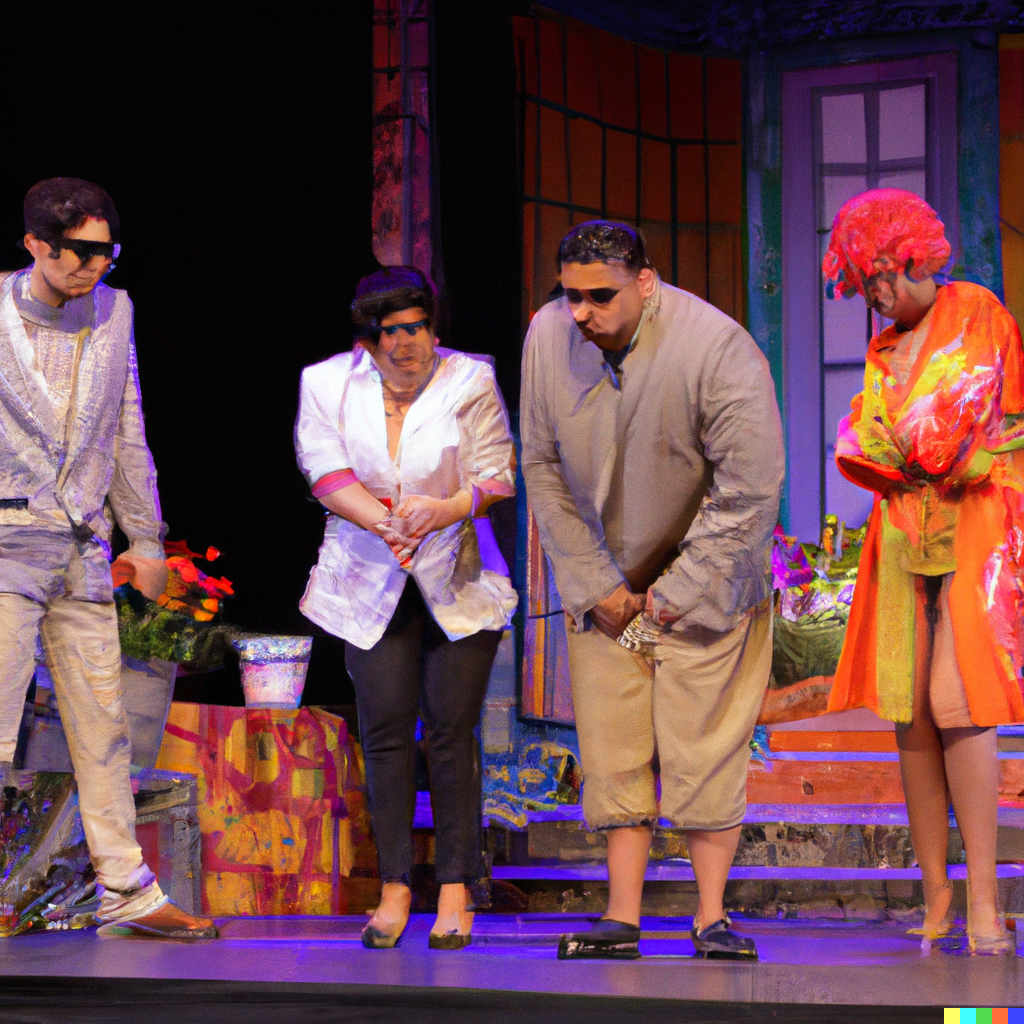
Image created by T. H. M. Gellar-Goad using DALL·E.
Two- and three-person scenes
Plautus Amphitruo 633–860. After being away for a long time at war, the mythical hero Amphitruo returns home to his wife, who has been sleeping with the god Jupiter disguised as her husband. They are confused by each other’s reactions, leading eventually to accusations of infidelity, cruelty, and lies. Jupiter amplifies the confusion by duplicating a prop, a golden bowl Amphitruo won in battle and planned to give to his wife but that she has already received from the god.
Readings:
- R. P. Bond, “Plautus’ Amphitryo as Tragi-Comedy,” Greece & Rome 46 (1999), pp. 203–220.
- David Christenson, “Grotesque Realism in Plautus’ Amphitruo,” Classical Journal 96 (2001), pp. 243–260.
- Jane E. Phillips, “Alcumena in the Amphitruo of Plautus: A Pregnant Lady Joke,” Classical Journal 80 (1984–1985), pp. 121–126.
- Christopher B. Polt, “The Humour and Thematic Centrality of the Patera in Plautus’ Amphitruo,” Greece & Rome 60 (2013), pp. 232–245.

“File:Goluchow Painter ARV 10 3 satyr playing auloi (03).jpg” by ArchaiOptix is licensed under CC BY-SA 4.0 .
Plautus Menaechmi 753–875. Because nobody in Epidamnus realizes there are identical twins both named Menaechmus, a nonstop comedy of errors and misidentification ensues, and everyone thinks everyone else is crazy. In this scene, Epidamnian Menaechmus’ wife and father-in-law have summoned a (quack) doctor to evaluate Menaechmus’ insanity — but which Menaechmus is it?
Readings:
- Lydia Baumbach “Quacks Then as Now? An Examination of Medical Practice, Theory and Superstition in Plautus’ Menaechmi,” Acta Classica 26 (1983), pp. 99–104.
- Susanna M. Braund, “Marriage, Adultery, and Divorce in Roman Comic Drama,” in Satiric Advice on Women and Marriage: from Plautus to Chaucer, ed. Warren S. Smith, (Ann Arbor, 2005), pp. 39–70.
- Elaine Fantham, “Mania e medicina nei Menaechmi e in altri testi,” in Menaechmi, edd. Renato Raffaelli and Alba Tontini (Urbino, 2007), pp. 23–45.
- K. F. B. Fletcher, “Characterization through the Use of Myth in Plautus’ Menaechmi,” Syllecta Classica 28 (2017), pp. 25–50 (only pp. 35–42).
Plautus Pseudolus 905–1037. The eponymous enslaved trickster meets his match in Simia, an enslaved trickster who knows everything Pseudolus wants before Pseudolus says it, and who outwits both Pseudolus and the sex-trafficker Ballio.
Readings:
- Christopher Bungard, “To Script Or Not To Script: Rethinking Pseudolus as Playwright,” Helios 41.1 (2014), pp. 87–106.
- Catherine Connors, “Monkey Business: Imitation, Authenticity, and Identity from Pithekoussai to Plautus,” Classical Antiquity 23.2 (2004), pp. 179–207.
- Alison Sharrock, “The Art of Deceit: Pseudolus and the Nature of Reading,” Classical Quarterly 46 (1996), pp. 152–174.
- John Wright, “The Transformations of Pseudolus,” TAPA 105 (1975), pp. 403–416.
Terence Eunuchus 539–614. The young man Chaerea describes to his military buddy Antipho what he has just done inside the sex-laborer’s house: disguised himself as the titular eunuch and raped Pamphila, the young woman with whom he is infatuated.
Readings:
- Christopher Bungard, “Navigating Tricky Topics: The Benefits of Performance Pedagogy,” Didaskalia 13 (2016–2017), pp. 39–48.
- Stavros A. Frangoulidis, “Performance and Improvisation in Terence’s Eunuchus,” Quaderni Urbinati di Cultura Classica 48 (1994), pp. 121–130.
- Sharon L. James, “From Boys to Men: Rape and Developing Masculinity in Terence’s Hecyra and Eunuchus,” Helios 25 (1998), pp. 31–47.
- Mogens Leisner-Jensen, “Vis Comica: Consummated Rape in Greek and Roman New Comedy,” Classica & Mediaevalia 53 (2002), pp. 173–96.
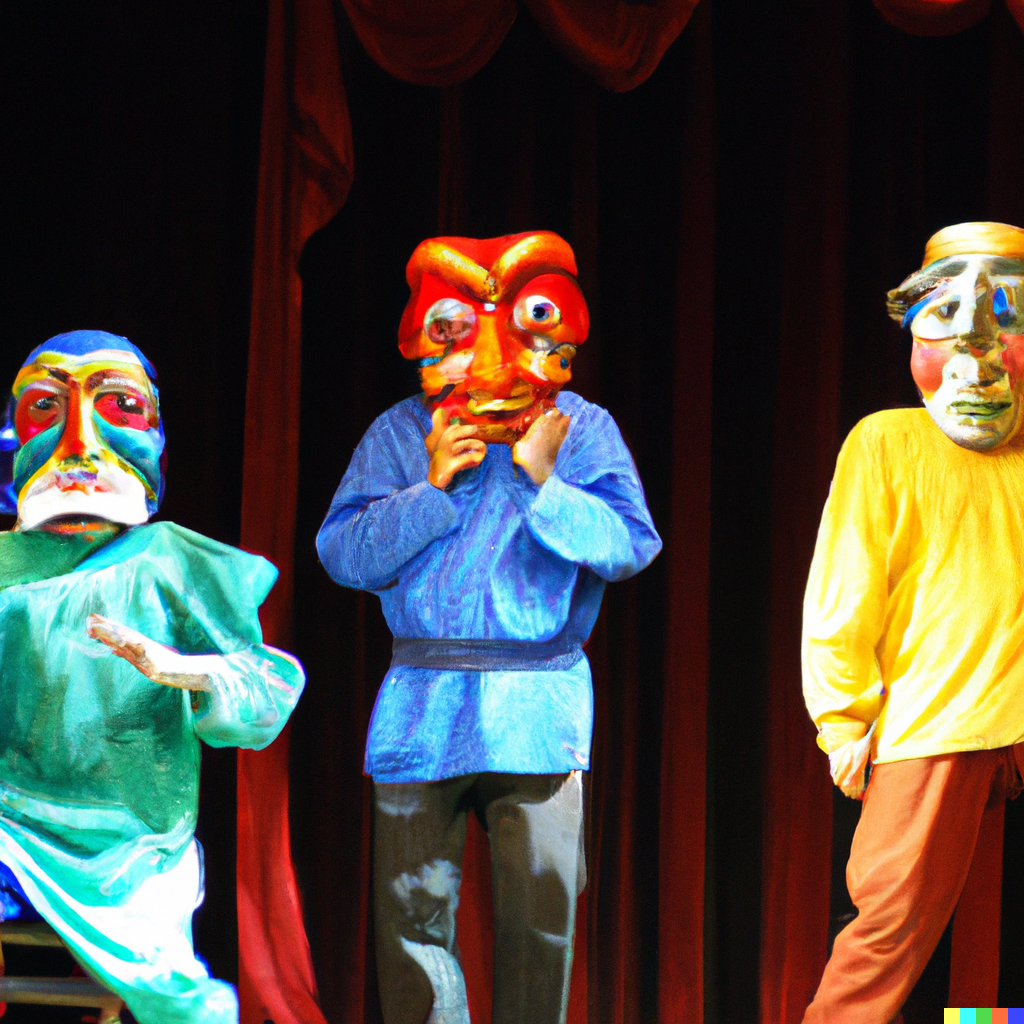
Image created by T. H. M. Gellar-Goad using DALL·E.
The Performance of Roman Comedy has been made possible by a major grant from the National Endowment for the Humanities: Democracy demands wisdom.

Any views, findings, conclusions, or recommendations expressed in this program do not necessarily represent those of the National Endowment for the Humanities.
